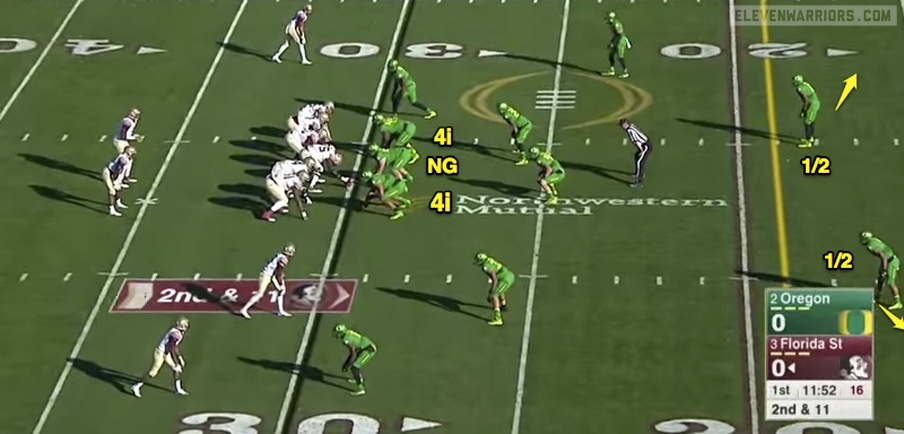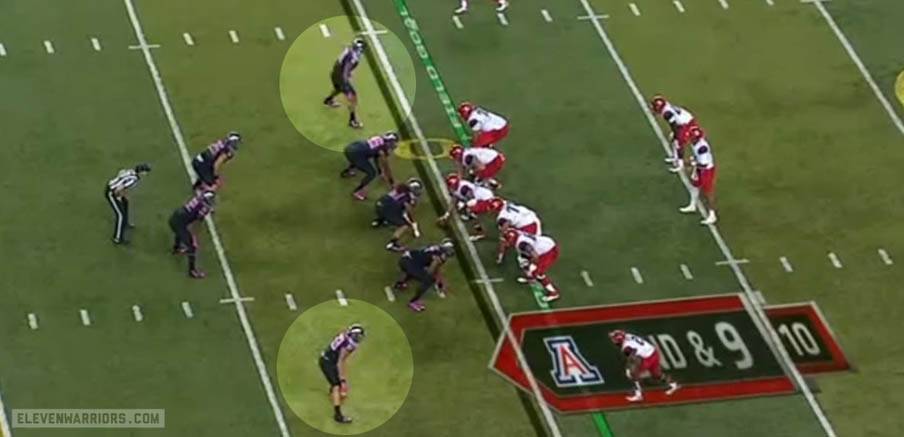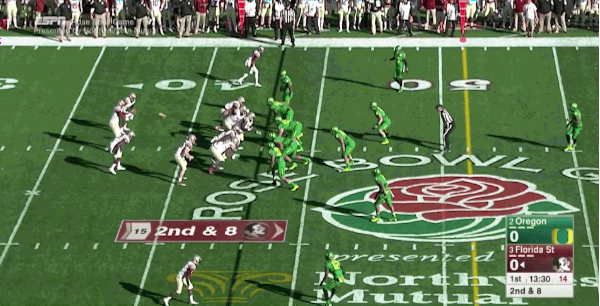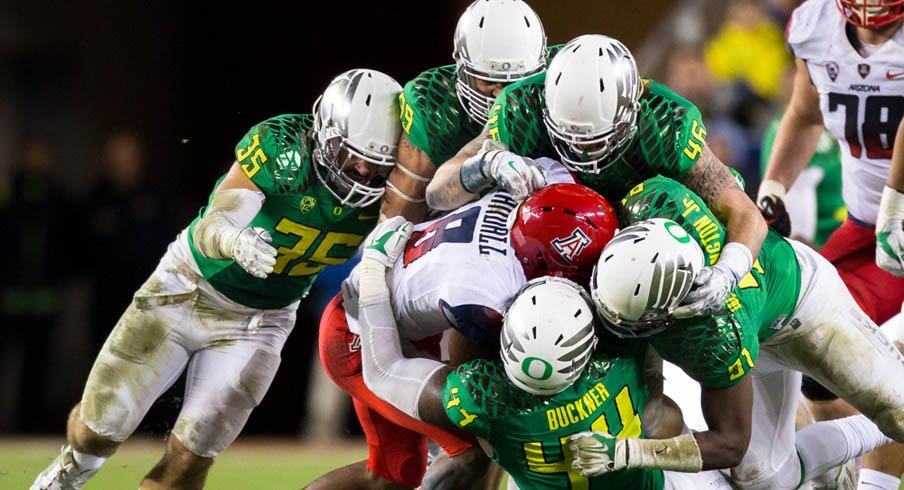Although often overshadowed by its prolific offense, the Oregon defense has also been instrumental to the Ducks' success. Utilizing a bend but don't break style, Oregon's goal is to force turnovers or hold team to field goals. The bet is that opponents will not be able to execute with the same proficiency to keep up with the Ducks' offense.
But despite Oregon's defensive improvement in recent weeks, the Ohio State offense retains a significant statistical advantage. The Buckeyes will have opportunities to exploit weak spots in the Ducks' defense. It is imperative that Ohio State protect the football and finish drives with touchdowns.
Passive Aggressive
Oregon Defensive Coordinator Don Pellum's 3-4 defense is a study in contrast. Up front, Oregon generally operates from a modified bear front, with a nose guard and two 4i technique defensive ends.

But the Ducks do not match the bear defensive interior with an aggressive approach. Pellum rarely utilizes blitzes. The defense instead generally rushes three or four. Oregon also frequently uses split safety zone coverage – cover 4 in run situations and cover 2 on passing downs.
That is not to say that Oregon plays entirely passive, just because they stay in their base defense. Against run-heavy spread teams, Pellum will keep his outside linebackers in the overhang areas, maintaining a cover 4 shell behind the front seven.

Oregon will also often zone blitz four while still dropping seven. For instance, one favorite is to bring both outside linebackers while dropping the nose guard in the underneath middle, allowing Oregon to rush their more athletic edge defenders.

But Pellum's general defensive philosophy is to limit the inside run and otherwise force teams to drive the length of the field.
This is reflected in the Ducks' defensive statistics. The Oregon defense is ninth in the country in Football Outsiders' F/+ rankings. But this ranking largely owes to two statistics – causing turnovers and limiting opponents in the red zone.
The Ducks otherwise fall well down the other statistical rankings. In fact, the Oregon defense is only top 30 in one other category. The upshot is clear – Oregon is willing to trade touchdowns for field goals, betting on the fact that the opponent will ultimately be less efficient than the Oregon offense.
Full Circle
For the Ohio State offense, it is perhaps fitting that they end the season facing a bear defensive front, given that much of the season was devoted to finding answers to that alignment following the loss to Virginia Tech.
The strength of the Oregon defense is their interior three defensive linemen. The Duck down linemen are long, and they look to use that length to stand up offensive linemen and prevent them from getting to linebackers. And the bear front limits the tight zone play.
So the Buckeye offensive line will need another strong performance. Oregon is statistically weak against the run and will allow first downs. And while Ohio State got away with converting third and longs against Alabama, the Ohio State run game must continue to function at a high level to put the Buckeye offense in more manageable third downs.
To do so, Meyer and Herman will need to utilize their counters to the bear front, such as gap plays like dart, and edge run plays such as sweep read and outside zone that were successful against Alabama's similar 3-4 front. Florida State had extensive success with outside zone in the Rose Bowl.

Power read – which attacks off tackle and the edge – will also be critical. Perhaps one of the biggest takeaways from the Sugar Bowl was that Cardale Jones showed himself adept at running the play and picking up critical first downs.
The Buckeyes must also find holes in Oregon's zones. If Pellum maintains a cover 4 shell to apply his outside linebackers against the run game it should provide opportunities for Ohio State to utilize hitch and vertical routes on early downs.
Rolled up cover 2 corners, by contrast, limit the Buckeyes' hitch routes. But Cover 2 is susceptible to double slants. Teams have hurt Oregon throwing to their running back out of the backfield. Such swing routes to Ezekiel Elliott were critical against bear fronts earlier this season.
And Florida State had success working the deep middle underneath the safeties – along with smash corner routes.
Against Alabama, Jones had success hitting crossing routes before the Tide's cover 2 safeties could break on the football. The Buckeyes must continue to take advantage of its down field opportunities and create more explosive plays than the Ducks.
Of the units in Monday's game, the Ohio State offense has the bigger statistical advantage in comparison to the Oregon defense. But the Ducks can limit that advantage if they continue what they have been doing this season – namely creating turnovers and limiting Ohio State to field goal attempts.
For Ohio State, it is imperative that they protect the football and maximize scoring opportunities. This includes finding ways to score touchdowns in the red zone with quarterback runs and edge plays against Oregon's packed interior.


